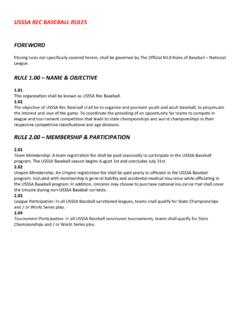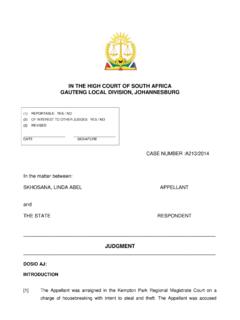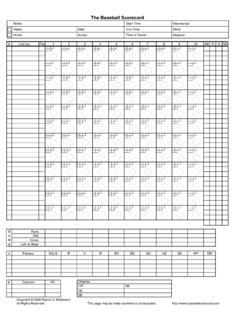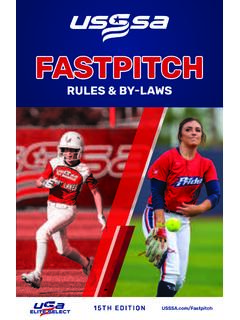Transcription of Strategic Wargaming Series HANDBOOK - Army War College
1 United States Army War College Strategic Wargaming Series HANDBOOK 1 July 2015 ii iii Strategic Wargaming Series HANDBOOK iv 2nd printing of the 1st edition. This printing includes corrections to typographical errors found in the first printing and is otherwise unchanged. This publication was written and edited by James Markley. Contributors included Jeffrey Brashear, William (Chip) Cleckner, Brent Kauffman, Ned Ritzman, Robert Scanlon, and Donald Travis. The views and opinions expressed in this HANDBOOK do not necessarily reflect those of the US Army War College , the Department of the Army, or any other agency of the US Government. To obtain permission to reproduce material from this HANDBOOK for commercial purposes, contact the editor for each use. Material may be freely reproduced for academic or other noncommercial use; however, it is requested that the Strategic Wargaming Division, US Army War College , be credited and the editor informed.
2 Send requests for publication and reproduction information to: Center for Strategic Leadership and Development, ATTN: Strategic Wargaming Division, 650 Wright Avenue, Carlisle, PA, 17013. v vi Table of Contents I. HANDBOOK Introduction .. 1 Figure 1. Wargame Process Macro View .. 4 II. Select a Topic .. 6 III. Define the Wargame .. 8 Figure 2. Define the Wargame Phase .. 8 IV. Plan Wargame Support .. 13 Figure 3. Plan Wargame Support 13 V. Design the Wargame .. 15 Figure 4. Design the Wargame Phase .. 15 VI. Develop the Wargame .. 20 Figure 5. Develop the Wargame Phase .. 20 VII. Rehearse the Wargame .. 23 Figure 6. Rehearse the Wargame .. 23 VIII. Execute the Wargame .. 26 Figure 7. Execute the Wargame .. 26 IX. Communicate the Results .. 30 Figure 8. Communicate Results .. 30 Appendix A: Selected Bibliography.
3 A-1 Appendix B: Wargame Project Team Duties .. B-1 Appendix C: Sample Wargame Slate .. C-1 Appendix D: Wargame Support Checklist .. D-1 1 I. HANDBOOK Introduction Purpose of This HANDBOOK This HANDBOOK is a reference for staff and faculty of the United States Army War College (USAWC) engaged in Strategic Wargaming . It may be particularly useful to new faculty members, especially new members of the Center for Strategic Leadership and Development (CSLD), Department of Landpower Concepts, Doctrine and Wargaming (LCDW), which is responsible for the USAWC Strategic Wargaming Series . It is also a resource for both US and International students at the USAWC who are interested in developing their own Strategic level Wargaming capability at some future point in their government service. Finally, this HANDBOOK serves as a reference for the USAWC students enrolled in the Strategic Wargaming elective.
4 Uses of This HANDBOOK The HANDBOOK provides a comprehensive overview of the Strategic Wargaming practices in current use at the USAWC. It is thus a guide to planning, preparing, conducting, and reporting on Strategic wargames as they most commonly occur at the USAWC. It does not attempt to explain the breadth of applications for Wargaming methodologies. Inasmuch as Wargaming is more of an art than a science, the procedures in this HANDBOOK should not limit the creativity and flexibility of those planning and executing a wargame. Rather, it articulates a holistic process to assist the Wargaming project team (aka the project team) in developing and executing an effective wargame. After a thorough review of this HANDBOOK , the reader should have a sufficient understanding of the way in which US Army War College s Strategic Wargaming division conducts wargames to be able to participate in a meaningful way as a member of a project team.
5 USAWC Wargaming Overview Introduction Strategic Wargaming supports the USAWC s education, research, and outreach missions. Through the planning, preparing, conduct, and reporting on Strategic wargames, the USAWC is able to provide information and insights into issues of a national or military Strategic nature to inform decision-making of the senior-most leaders of the US Army, our fellow Services, and across the Joint Force. The USAWC conducts approximately 7-8 wargames per year, principally for the Army Staff, Army Service Component Commands, Combatant Commands, and occasionally other DoD and government organizations. Why Wargame? Wargaming serves several purposes that are of value to the Army and other military organizations. At its core, a wargame is a tool for exploring and informing human decision-making. Since the USAWC primarily conducts strategically focused wargames; the ideas, issues, and insights uncovered during the conduct of a wargame can have far-reaching effects on US national and military policy, planning, and decision-making.
6 2 During the course of a wargame, players often discover the need to make unanticipated decisions in order for the game to progress. The rationale associated with decisions reached in the game-world may illuminate the need for real-world decisions while also informing the decision itself. USAWC wargames generally use qualitative analytical techniques that allow for the exposure of ideas, issues, and insights not otherwise readily obtainable through the application of quantitative analytical techniques. While not an explicit objective of the USAWC Wargaming Series , there is an educational component to each wargame. Experience has shown that players learn from each other while participating in the wargame. Most players find the exchanges of ideas and information that occur during a wargame to be professionally rewarding. The USAWC Strategic Wargaming Series From the USAWC s perspective, a Strategic wargame is a structured, facilitated interaction between experts on a topic that will inform and assist in future Strategic decision making by improving understanding of the pertinent issues.
7 Results from a wargame can provide insights and options on the employment and appropriate application of the instruments of national power. Through the Strategic Wargaming Series , the USAWC conducts timely and relevant wargames to address select issues of Strategic importance to the US Army and the nation. USAWC usually conducts its wargames on behalf of a sponsor to investigate, research, or analyze issues or areas that other organizations are not typically addressing. These wargames commonly deal with political-military issues at the high operational to Strategic levels of war. USAWC wargame participants include highly qualified experts from the USAWC staff, faculty and students, US and foreign government departments and agencies, non-governmental organizations, other academic institutions, and relevant think tanks from around the world.
8 For USAWC and the participants, there is inherent value in the exchanges of ideas and critical thought among a highly qualified, diverse array of wargame participants. USAWC wargames help to build and expand professional networks for regional and functional communities of interest. USAWC Wargaming Niche The Strategic Wargaming Series leverages the USAWC s unique characteristics and capabilities to address matters of national security interest as they relate to the instruments of national power. The vast majority of USAWC wargames focus on the military instrument of power in general and the employment of Landpower in particular. As an academic institution, the USAWC has a degree of freedom to address potentially contentious issues that might not exist in other military organizations. The USAWC is home to a seasoned faculty with recognized experts covering a broad range of subjects across the military and international relations domains.
9 In addition to the faculty, USAWC students and War College fellows from across government and the military services add valuable insights based upon extensive, diverse experiences. 3 The USAWC is able to draw on as many as 80 International Fellows each year to participate in the wargame Series . This select group of senior foreign military officers, while not directly representing the interests of their government or military, enables USAWC to integrate international perspectives into its wargames to great effect. In order to foster frank and open discussion and, unless otherwise negated by the wargame sponsor, USAWC wargames are conducted under strict rules of non-attribution. Participants (players and controllers) may not attribute comments or discussion points to any other participant. Likewise, wargame reports will not attribute comments to any participant or the participant s organization.
10 Reports usually include a listing of the players names and organizations unless a player declines being included in that list. Characteristics of the Wargame HANDBOOK This HANDBOOK is organized around the major phases associated with planning, preparing, conducting, and communicating wargame results. While each wargame is unique, the phases highlighted below and detailed throughout the HANDBOOK serve as a strong foundation for the efforts of the project team that plans and executes a wargame. As previously mentioned, this HANDBOOK explains the current process used at the USAWC to assist wargame planners in carrying out an effective wargame. Since this HANDBOOK is a reference for the USAWC wargame project team, it contains more detail than might be found in similar books on this subject. The Wargame HANDBOOK is process-focused. While the overall process generally flows in sequence where subsequent activities are dependent upon previously completed activities, some activities will be completed out of order due to time constraints or as information becomes available.







